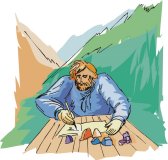
Worksheets and No Prep Teaching Resources
Reading Comprehension Worksheets
Earth Science

Earth Science
 Worksheets and No Prep Teaching Resources Reading Comprehension Worksheets Earth Science |
 Earth Science |
| edHelper's suggested reading level: | grades 9 to 10 | |
| Flesch-Kincaid grade level: | 9.55 |
|
Mineral Detectives, Part I
By Trista L. Pollard |

|
 1 It takes a well-informed scientist to distinguish between the over 3,000 different types of minerals on Earth. These scientists, mineralogists are responsible for examining, analyzing, and classifying minerals. Think of them as "mineral detectives." They use the physical properties and some special properties of minerals to help identify these substances.
1 It takes a well-informed scientist to distinguish between the over 3,000 different types of minerals on Earth. These scientists, mineralogists are responsible for examining, analyzing, and classifying minerals. Think of them as "mineral detectives." They use the physical properties and some special properties of minerals to help identify these substances. |
Create Weekly Reading Books
Prepare for an entire week at once! |
| Leave your feedback on Mineral Detectives, Part I (use this link if you found an error in the story) |
 |
Earth Science
|
 |
High School Reading Comprehensions and High School Reading Lessons
|